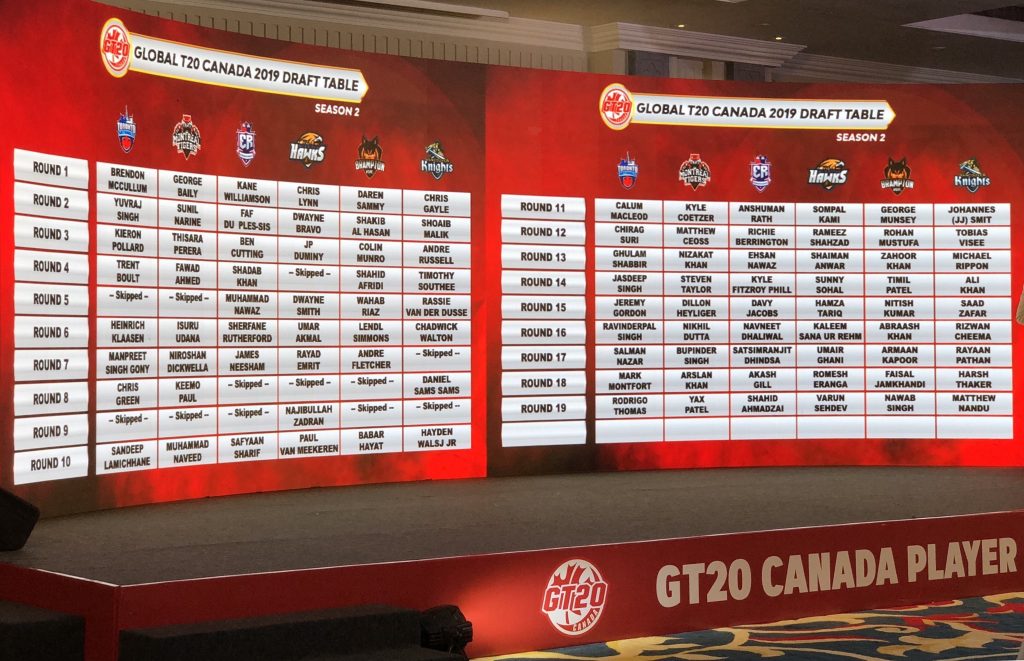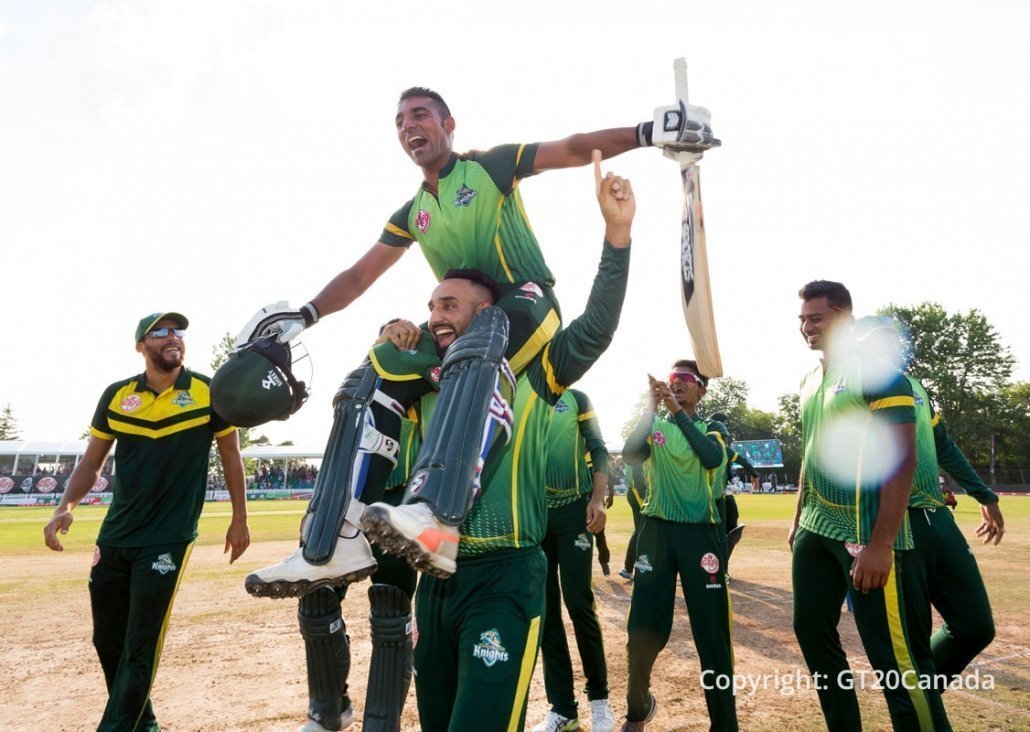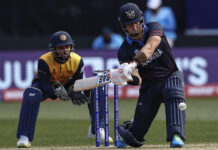As David Warner was picking off the Bangladesh bowlers around Trent Bridge, and Germany was getting oh-so-close to slipping past Jersey to the T20 World Cup qualifier, the GT20 Canada draft event was being streamed live from Mumbai.
Sixty Associates – almost 60% of GT20 player numbers – were selected across the six franchises. Their numbers constituted nearly 60% of total players numbers, but only 15% of the total salary purse. Their average was just under $8,600 and the median price $4,500. The minimum of $3,000 went to almost half of the players.
Among the 42 Full member salaries, the average was almost $65,000 with a median of $75,000.
In short, this can be done better. It’s not a matter of artificially inflating the prices for those for emerging nations, but with a few tweaks to the draft process it can be done – and not cost the event or franchise owners any more.
THE EVENT
The five hour affair had a lot going on. The first sixty minutes were taken up by some lengthy opening speeches about the goals of the tournament and lumping praise on the various successes of year one, and then the creator of the app that will cover GT20 spoke for almost 20 minutes in what resembled a pitch to investors, rather than a launch announcement.
Considering the magnitude of the news in terms of notoriety, sponsors and TV interest, it was an intriguing decision to wait a good hour, and in the middle of confirming the marquee players, for the announcement that many (ie us) had predicted: Indian legend Yuvraj Singh would indeed play in the event.
Be that as it may, it is huge news for the event. When Kowloon Cantons had the signature of Yusuf Pathan to play in the 2017 HK T20 Blitz, Cricket Hong Kong had Indian TV deals on the hook, and with them, subsidised global distribution.
As soon as his No Objection Certificate (NOC) was rescinded, so were the broadcast deals.
Similar to the Blitz, the also speedily-organised inaugural GT20 got great exposure due to the presence of Aussie stars. For the Blitz, it was a recently retired Michael Clarke. In 2018 the cricketing world looked to Canada to see how Messrs Smith and Warner would perform in their first ‘major’ playing appearance since the Cape Town saga.
That’s not to demean the scale of the dream (and investment) in the first GT20, there was a lot of interest as to how a “global” T20 event, with so many global stars – perhaps even superfluously so – could drive interest from an event in North America.
THE DRAFT
That brings us to the last four hours of Thursday’s event, the player draft. Each franchise had to pick seven FMs, five Canadians, one ICC Americas player and four other Associates.
The first nine rounds were simple enough. Teams had to pick their seven names from those “International” (Full member players only) rounds, meaning they would need to skip two. Most teams front-ended their picks, with only four players selected across the last two rounds. As well as being the only Afghan selected of 66 in the draft, Najibullah Zadran was the lone name in the final round.

The prices for the FM round started at $100,000 for each of the Marquee players selected in the first two rounds and from then it went $90,000, $75,000, $60,000, $40,000, $25,000, $15,000, $10,000.
All players had submitted their base prices and this appeared to work; only those with reserves set at or below the round price were selected in corresponding rounds.
After a simple round/draft format the event organisers appear to have come up with a completely different format for the selection of the remaining 10 players in each squad of 17.
For the Associates, there were no set round prices and instead of having a list of players to select from whose reserve was at or above the relative amount the teams were given the list of players and informed that the players’ “prices were there on the list”.
This resulted in the players selected across the four non-American Associates rounds and the five Canadian slots being purchased for their reserve price only, ie the lowest amount they were willing to compete for, no matter which round they were picked in. They were not rewarded with a contract relative to when they were selected. (The players we have spoken to were under the impression they were only ever submitting a reserve price, not their actual selling price.)
This resulted in a huge disparity across same-round pick prices.
It is easy to say “the players are pros, they’re used to IT”, however, these guys aren’t full-time, only a few of them have (had) contracts
Take round one (in order of selection); Sandeep got $60,000, UAE’s Naveed went for $30,000 (after initially being put up on the screen for only $3,000), Safyaan Sharif of Scotland netted only $3,000, Paul van Meekeren a healthy $15,000. Babar Hayat, who was excellent for the champion Vancouver Knights in year one; $3,000.
Hayden Walsh Jnr of USA was somehow also picked up in that first round. He only went for $3,000.
To put it another way, BramptonWolves, owned by the GT20, selected their entire Associate cohort for $37,000 (in order of selection); Babar Hayat, George Munsey, Rohan Mustafa, Zahoor Khan, Timil Patel, Nitish Kumar, Abraash Khan, Armaan Kapoor, Faisal Jamkhandi, Nawab Singh. Sandeep (Toronto) was $60K.
This pricing pattern continued into the ICC Americas and Canadian rounds.
Teams were restricted to one ICC Americas player and this was to be picked in only one round, the 14th. Forgetting what appears a mistake with Hayden Walsh (and notwithstanding any other ideas about how the draft could’ve been structured better) maybe it would’ve been easier to have a simple rule that of your five Associate picks, a minimum of one had to be from ICC Americas.
Overall this has created a slightly worrying state of affairs – especially within Canadian ranks. It is easy to say “the players are pros, they’re used to it all”, however, these guys aren’t full-time, only a few of them have (had) contracts but most were taking time off their ‘normal’ jobs to stay with the squad in fighting for one of the four ODI spots on offer at WCL2.
Yes, the players are fortunate that Mercuri (now Bombay Sports Group) chose Canada to base their “Global T20”, but it has been made clear by organisers and Cricket Canada that this was not only to build a successful venture for the owners (under a 25 year licence don’t forget) but to help grow the sport in the country.
Canada recently finished fifth in April’s World Cricket League Division Two, which means no ODI status and a funding differential of around $500,000 to those seven Associates above them in the new CWC League Two.
We also haven’t heard anything further about the contracts promised to those players successful at trials in early 2019. Cricket Canada recently redid their website and all old stories have disappeared but here’s cached link and a screen grab follows.

Organisers have created a situation where any healthy demand for players from Associate nations, including Canada, is stifled; and they are restricted to (generally) lower prices.
The same thing happened to the ICC Americas players in the CPL draft – albeit on a smaller scale. The players were assigned a singe round where they could be selected and not counted within the overseas quota, but this meant the players were all only ever going to earn that stipulated (low) amount. Ali Khan was retained by his franchise – he was near the top of the wickets list for the CPL champions – and he will get the same $3,000 as the other ICC Americas players picked. Sandeep Lamichhane was drafted for $70,000. If American players could have been selected in any round, and a higher level set for those retained players like Khan, this disparity could’ve been easily avoided.
Perhaps a more simple structure where the five GT20 Associate rounds with prices set at, say, $25k, $20k, $15k, $10k, $5k – where players only appear who are at/below that amount for their reserve – would have worked better, but this doesn’t go far enough.
Each franchise had to pick 7 FMs, 5 Canadians, 1 ICC Americas players and 4 from other Associates.
Why not have 20 rounds, starting at $100k and working their way down, allowing teams to select any player in any round, as long as they end up with the right squad split? Structured correctly it wouldn’t cost any more, and there’s a level playing field for all. Sandeep may have been picked up in an earlier round for more money like he was for the CPL, and players would rightly be remunerated by the round they were selected in, as it should be in any draft situation.
They say everything is easier in retrospect but considering what’s being invested in this event – and the Euro T20 Slam by the same owners – here’s hoping they are able to change this in order for the (great) opportunity presented to Associate players on the pitch, to be matched by their compensation off it.






